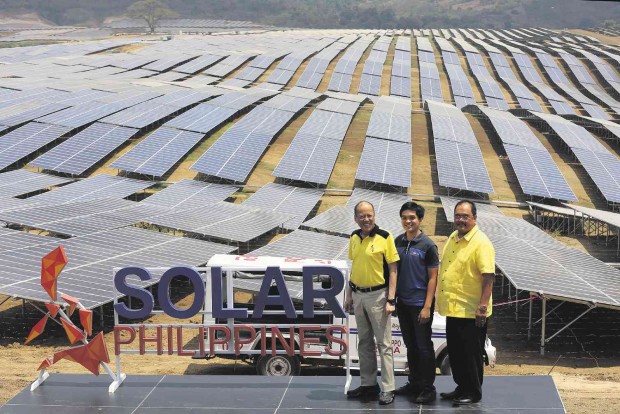
‘SMART’ SOLAR FARM Days after former US Vice President Al Gore said in Manila it was not smart to build coal-fired power plants, President Aquino, along with Leandro Leviste (center) and Energy Undersecretary Donato Marcos, leads the launching of a 63.3-megawatt solar farm founded by Leviste in Calatagan, Batangas province. JOAN BONDOC
PRESIDENT Aquino on Wednesday inaugurated the 63.3-megawatt Calatagan Solar Farm, the biggest solar farm in Luzon that has claims to be able to power the noontime energy needs of western Batangas.
Solar Philippines CEO Leandro Leviste said the Calatagan Solar Farm is one of the first of dozens of solar projects completed this year. It began operations just weeks before the Department of Energy’s (DOE) March 15, 2016 deadline for projects seeking eligibility for feed-in-tariff (FIT) incentives.
The FIT system is a scheme to allow accelerated development of renewable energy by offering incentives to renewable energy producers such as long-term contracts and higher prices for renewable electricity they supply to the grid.
The DOE has started checking on solar power projects and reviewing applications of companies that have applied for FIT. Companies wishing to qualify for FIT should have projects that are completed, switched on, and exporting power to the Luzon and Visayas grids on or before March 15, said DOE assistant secretary Mario Marasigan.
Right on time
The President inaugurated the project a day after visiting former US Vice President Al Gore called on the Philippines to end its dependence on coal. Gore warned that if such actions are not taken, rising sea levels caused by climate change may threaten 13.6 million Filipinos living in coastal areas.
Experts have said that the Philippines, because of its abundant sunlight, can become one of the world’s first 100 percent renewable energy-powered economies.
At Wednesday’s inauguration, Mr. Aquino highlighted the global significance of projects such as the Calatagan Solar Farm. “Through projects like these, we are proving to the world that even developing countries such as ours can do their share in combating climate change,” he said.
Leviste said the solar farm is among the largest to be completed in Luzon. It comprises over 200,000 panels on a 160-hectare property, and supplies enough power for the entire western Batangas. Over three decades, it will offset over 1 million tons of carbon dioxide, equivalent to planting over 5 million trees. During construction, it employed 2,500 workers, and will continue to employ at least 100 people over 30 years.
He said this is the first solar farm developed, financed, and constructed entirely by local companies. The project is being financed by Philippine Business Bank, Banco de Oro, Chinabank and Bank of Commerce, he said.
The company will soon begin construction on its next projects in Mindanao and Luzon, and aims to complete 500 megawatts by 2017, he said.
Promoting solar energy
Solar Philippines under Leviste, the 22-year-old son of Sen. Loren Legarda, also built the largest solar roof top at SM North Edsa, which President Aquino also launched in November 2014.
Leviste was very lavish in his praise of the President at the event. He credited Mr. Aquino’s renewable energy policies for leading the country to promote and utilize solar energy.
“Because of President Aquino’s visionary leadership, we have crossed the point of no return in our country’s shift away from fossil fuel. For many years, the conventional wisdom was that solar was only a marginal share of the energy mix,” Leviste said in his speech.
In 2016, the Philippines has become the largest solar market in Southeast Asia and one of the largest among emerging markets worldwide, he said.
“Solar has just begun to realize its potential. It will soon not only be cleaner, but cheaper and more reliable than coal, and in a matter of years, supply the majority of our country’s energy needs,” he said.
Only a few days ago, Legarda had criticized the Aquino administration for allowing the construction of 25 coal-fired power plants in the country in the next decade.